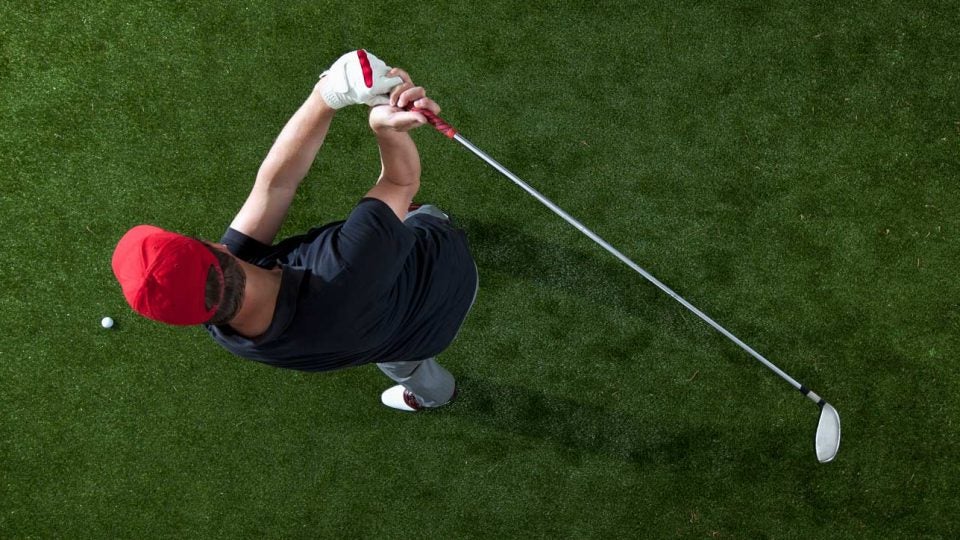 Why Newton Motion shafts are taking over the Champions Tour
Why Newton Motion shafts are taking over the Champions Tour
Yo, Gear Guy! Will a longer driver shaft give me longer drives?

Welcome to another edition of Yo, Gear Guy!, an interactive GOLF.com series in which our resident dimplehead (a.k.a., GOLF’s deputy editor of equipment, Mike Chwasky) fields your hard-hitting golf gear questions. This week he explores the theory that longer driver shafts equal increased distance, the importance of face inserts on putters and more.
Cmillr on Instagram: There are a lot of putter face inserts out there – how do I choose one and why aren’t they used in full swing clubs?
There a lot of different putter face designs available these days, some of which feature inserts and some that don’t. Scotty Cameron putters, like the new Phantom X, feature a multi-material design with a solid piece of milled aluminum in the hitting area, while Odyssey’s Stroke Lab Tuttle putter has an elastomer insert with hinges that flex at impact to improve roll. Evnroll putters are one-piece milled stainless steel with a “Sweetface” milling pattern with varying groove depths for more consistent distances across the entire face, while Ping Sigma 2 putters feature the a Pebax dual-durometer face with TR technology that also evens out speed on heel and toe hits to provide more distance control.
I could go on, but I think you get the point – there are a lot of ways to skin a cat and while each of the aforementioned designs are outstanding (as are others like TaylorMade’s Spider X Pure Roll insert) it’s important to keep in mind the face, with or without insert, is just one factor in finding a flatstick that works for you.
In addition, you should look at clubhead weighting (face balanced, heel toe, etc.) to see what works well with your stroke, overall balance, clubhead style (mallet, blade, etc.), overall length, and alignment aids, among other things. In some cases the insert might be the key factor in your decision while other times it might not.
As far as the second part of your question goes, inserts are used in many full swing clubs, but usually for a different purpose than with putters. For example, every modern driver and just about every game-improvement, max game-improvement, or players distance iron, is built with a thin face insert. These inserts flex like mini trampolines at impact to provide increased COR, ball speed, distance and even forgiveness. They also help lower spin rates and increase launch angles. So while face inserts play a significant role in putter design and performance you can argue that they play an even more critical role in full swing clubs. Just FYI.
ADVERTISEMENT
HayesS23 on Instagram: I basically use any tee I can find but one of my buddies only uses specific color-coded tees. Is he insane or what?
I definitely wouldn’t use the term “insane” to describe your friend, more like slightly anal-retentive. But while I completely understand your view, he’s definitely not alone in his desire to add as much consistency to his tee game as possible. Nailing the same tee height time after time (depending on what type of shot you’re trying to play) is critical, and better players often go out of their way to ensure this aspect of their game is solid. In fact, lots of PGA Tour pros use what is most likely the same model your friend uses, Pride PTS tees, which feature the “color codes” you mentioned in your question.
These tees (and others) provide a guide on the stem that allows players to achieve consistent tee heights by simply sticking the tee in the ground up to the colored stripe. It’s not rocket science, but it works very nicely. I know it’s easy to make fun of your friend for trying to look like a Tour pro, but in this case it’s no joke – one of the biggest advantages you can get from your equipment in general is reducing the number of variables in the equation, which a color coded tee can definitely do.
Sydcheeks on Instragram: I’m told the easiest way to pick up speed and distance is to use a longer driver shaft. True?
Typically most players do pick up speed (around 1 mph per inch) with a longer driver shaft, and since every 1 mph of additional driver speed generally yields about two yards of extra carry distance, technically the advice you’ve been given is true.
However, not all players get the same results for a variety of reasons, and while most OEMs (original equipment manufacturers) have determined that 45″ – 45.75″ is the optimal length for most players, there’s a lot of indications that these lengths are actually too long for some folks. Remember, the most important element when trying to produce distance is solid contact. Once you can do that you can then set your driver up to produce the optimum spin rate and launch angle for your speed.
I’ve personally experimented with different driver lengths over the years and checked the results both on the course and with a launch monitor. What I’ve found is that while I might gain some speed with a longer shaft, my quality of contact and smash factor (efficiency of strike) go down as shaft length goes up.
For example, I once tested a 43.5″ driver that I felt very comfortable with against a 46″ model that a fitter set up for me, and the results were interesting to say the least. While my speed predictably went up about 3 miles per hour (which theoretically could yield six or seven more carry yards), my smash factor dropped precipitously and my dispersion became unacceptably poor. And though I did get about one extra-long bomb out of five with the long shafted model the other four hits were honestly terrible. In contrast the shorter model yielded a maxed out smash factor of 1.51, much better dispersion, and longer distances on average.
The lesson here is while longer shafts are a quick way to add raw speed to your swing, they don’t necessarily allow you to hit the ball longer (or straighter) on average. My advice for those interested in increasing driver distance is to get properly fitted for loft, face angle, shaft length, shaft flex, grip size, and clubhead model. Find the combination that allows you to swing with as much confidence and comfort as possible rather than the set up you swing the fastest, and you’ll be in the best position to maximize your overall driving stats.
To receive GOLF’s all-new newsletters, subscribe for free here.
ADVERTISEMENT







